One of the best things about the Ruger 10/22 is that there are endless ways to customize one to suit your exact needs or desires. For me, that means heavy aftermarket barrels, replacement trigger groups, and colorful aftermarket laminated stocks. So when I saw Altamont’s new KKC stock at the 2015 SHOT Show, I had to have one. It took a while, but I finally acquired one and it was worth the wait . . .
The KKC stock is named after its inventor, a Norwegian named Kjetil Kverndokk. According to his website, he invented the stock in January 1998 as part of a college dissertation project from The Institute of Industrial Design at The Oslo School of Architecture and Design in Norway. Mr. Kverndokk began commercial production of his rifle stock in 2005. In the early years, he sanded, stained and mounted the stocks himself. He eventually partnered with Altamont to produce the stocks for the U.S. market. Altamont showed off a prototype at the 2015 SHOT show:
Who the heck is Altamont?
Altamont may just be the biggest gunstock company you have never heard of. Founded in the 1980s, the company cut its teeth supplying low-volume, high-quality specialty grips to major gun manufacturers. As an example, Altamont made the genuine ivory grips for Colt’s John Wayne series, as well as the Elmer Keith Commemorative for Smith & Wesson.
Word soon got out, and Altamont began contracting to make grips and handles for such companies as Bear Archery, Buck Knives, Weatherby, Taurus, Kimber, Beretta, Smith & Wesson and Colt. Like most well-run small companies, they reinvested the profits into infrastructure: they expanded to a modern, 70,000 s.f. facility located on three acres of land in Thomasboro, Illinois. With new capacity, Altamont began completing OEM work for companies in Korea, Japan, Italy, Germany, among others. Altamont has gradually added direct consumer sales into its business model, which leads us to the KKC stock….
Back to the KKC Stock….
The KKC rifle stock is made from Rutland Laminated Stratabond plywood, which is the same wood used by Boyd’s. Apparently, Rutland’s factory in Vermont completely burned to the ground last summer, so future stocks may be made of other materials.
I own at least five rifles made with Rutland Stratabond and have never had a problem. The finish on one of my Boyd’s stocks did prove to be somewhat vulnerable to Birchwood Casey Gun Scrubber, so I would assume the same would be true here. I now remove the laminate stocks from the barreled actions before using this product.
One of the biggest problems with previous stocks I’ve used is that they are often only comfortable in one shooting position. In other words, a stock might work well on the bench, but is difficult/uncomfortable to shoot offhand. Thumbhole stocks are usually the worst offenders in this regard.
The KKC stock, on the other hand, has the benefit of being very flexible. While it’s designed for hunting applications and offhand shooting, it’s also comfortable shooting from the bench. To test out this stock, I slapped it onto one of my Ruger 10/22 Targets, installed a Harris bipod, and took it on my annual squeakie shootin’ trip with Roe Outfitters in Klamath Falls, Oregon.
For those who don’t know, Belding Ground Squirrels (aka “squeakies” or “sage rats”) are similar in appearance to prairie dogs, but much smaller. They are cute little bastards:
But they are also a major pest to farmers because they can literally wipe out an entire crop in less than a month. So we shoot them…by the thousands! They look like this after meeting a .17 HMR:
In the farm fields we shoot in, each of the irrigation pivots can harbor tens of thousands of these little critters. That’s great news for anyone who likes shooting rimfire: we shoot straight through from 8am to 6pm, and it’s easy to shoot 2000-3000 rounds a day at these mobile non-resetting targets. But if you have an uncomfortable stock or a crappy scope, you will definitely know it by the end of the day. So my April 2105 trip was an ideal test for evaluating whether the KKC stock works well from the bench for high-volume shooting.
So with that intro in mind, let’s go through the KKT’s three key features, starting with perhaps the most important feature: the hand grip.
Hand Grip
One of the best features of the KKC stock is its handgrip. I have owned at least 10 other rimfire rifle stocks so I feel qualified to opine on this topic. Without a doubt, the asymmetric European wooden .22LR stocks, made by companies such as Anschutz, and the old-school Walther UIT/KK stocks are famous for the generous palm-swell feature, and I think they work really well. For me, the “thumbhole” stocks such as the Boyd’s Thumbhole Varmint are the worst, because they just don’t fit my hand correctly. YMMV. The KKC has a moderate palm-swell and no thumbhole. When you spend 10 hours in the pivots shooting squeakies, you really get to appreciate how comfortable the KKC’s handgrip is.
Instead of a thumbhole, which tends to limit the comfort range to a few shooting positions, the KKC stock’s pistol grip gives a natural and relaxed angle for your wrist over a wide range of shooting positions. A thumb shelf is carved into the top of the grip. It is also laser stippled to increase its tactile grip.
The stock’s hand grip has a near vertical rack, which is a common feature of European stocks and sniper stocks such as the McMillan A5. Being able to keep your wrist perpendicular to the ground (i.e. in line with the rifle) is much more comfortable when compared to having to bend your wrist as required with a more traditional “hunting” rifle stock. With the vertical grip, you can place your thumb on top of the grip, and the rest of your hand – other than the trigger finger – is relaxed.
Forearm
Another great feature of the KKC is the wide wedge-shaped fore-end. While perhaps more weighty than most “American” style hunting stocks, the fore-end of the KKC stock is rounded and is therefore very comfortable both for shooting and carrying. It also has the extra width to provide stability when shooting off of a backpack or shooting bags.
The barrel channel is supposed to be free-floated about ¾ of the way down the stock. I was sent a very early production T&E sample that does not have a wide enough barrel channel to free float the factory Ruger Target barrel. It first, I was disappointed by this, but I decided to shoot the rifle before embarking some sort of bubba inletting project. Fortunately, the rifle shot just as well – if not better – with the new stock so I left it as-is. But my sample is not technically free-floated. In talking with Doug Degroote from Altamont, my understanding that current production models are free floated.
Buttstock & Adjustable Cheekpiece
The buttstock is the most unique feature of the KKC stock. It is unique insomuch as it has two key features normally associated with target stocks: adjustable cheek pieces and adjustable recoil pads. The cheek piece can be adjusted upward 20 mm (roughly 8/10th of an inch). The recoil pad closest to the wood can be adjusted up .3 inch or down .8 inches, and the Length of pull can be increased as well (See photo below).
Unlike most target stocks, however, the designer of the KKC stock wanted to keep it lightweight, so he hollowed out the bottom of the buttstock. As a result, the KKC stock maintains very good balance. The balance point is right at the halfway point between the muzzle and the buttpad – directly in the middle of the firearm. This balance point is a bit more forward than most American hunting rifles, but I think it works out really well for a bull-barreled Ruger 10/22.
Sling Swivels
The KKC stock comes complete with two sling swivels. To be honest, I never used them for their intended purpose, but I did use the front sling swivel to mount my Harris bipod!
One last parting thought: the KKC stock that I saw at SHOT show had a cheek-piece that matched the color of the stock (see photo above). My T&E sample, on the other hand, had a black cheek-piece. Now, beggars can’t be choosers, so I won’t complain, but I were purchasing this stock I would greatly prefer the cheek-piece to match the rest of the stock. I think for now they are all being made with black cheek pieces.
All in all, I am very pleased with the Altamont KKC stock, and can recommend them without hesitation.
The MSRP for this stock is $225.00. They can be found either by Altamont directly or through Dr. Frankenruger. I have found that the Dr. Frankenruger site has these stocks on sale periodically.
Specifications:
Weight: 2 lbs, 3 oz
Length: 30 ¼ to 31 inches
Length of Pull (LOP): Adjustable 13 ¾, 14, or 14 1/4 inches
Barrel Channel: For .920 inch barrels.
Colors:
“Natural” (light brown, dark brown, and reddish brown layers).
“Winter Woods Gray” (light brown, light gray, dark gray layers).
“Everglades Green ((Green, brown, gray).
Note: The “Blue/Gray” and “Autumn Leaves” colors were apparently a limited production run).
Ratings (out of five stars):
Ergonomics: * * * * *
I own many .22LR rifles with a plethora of aftermarket stocks, and I can say that this stock ranks up there with my favorite Anschutz and Walther stocks.
Fit: * * *
The KKC stock is a drop-in unit, and fit is decent, but not perfect. In some places, the stock’s generous cut leaves a small gap. It’s certainly on par with other stocks like by Boyd’s Blaster, and since it’s more an aesthetic issue than a functional issue, I’m not complaining.
Adjustability: * * * * *
Adjustable cheek piece and butt pad are unique (and highly desired) features for a Ruger 10/22 stock.
Workmanship: * * *
There were a couple of flaws in the laminate pattern (for example, one of the gray layer should have been a blue layer), but other than that, the workmanship and finish of the stock was quite nice. I especially liked the laser stippling pattern, which was well executed and had a good texture.
Overall: * * * *
I’m very pleased with this stock, and would consider purchasing similar KKC stocks for other hunting rifles if they are offered.
By the way… I often get folks requesting information about the gun featured in any given article. To answer those questions, here is the G-2:
- Ruger 10/22 Target
- Kidd Trigger Pack
- DPI 15 MOA picatinny rail
- Leupold VX-2 (2-12 x 40) with custom target turrets.
- Warne Rings
- Harris Bipod (or perhaps a cheapo copy in some photos).

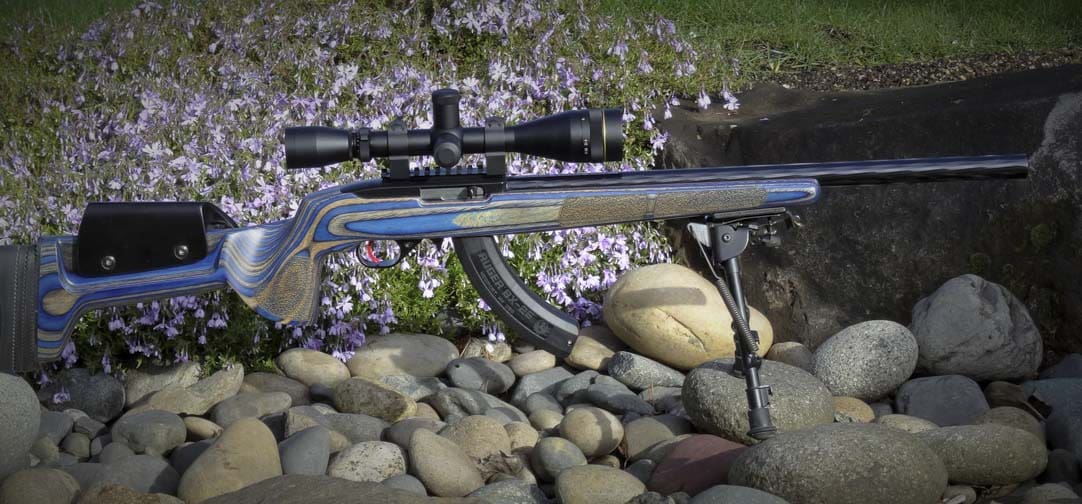
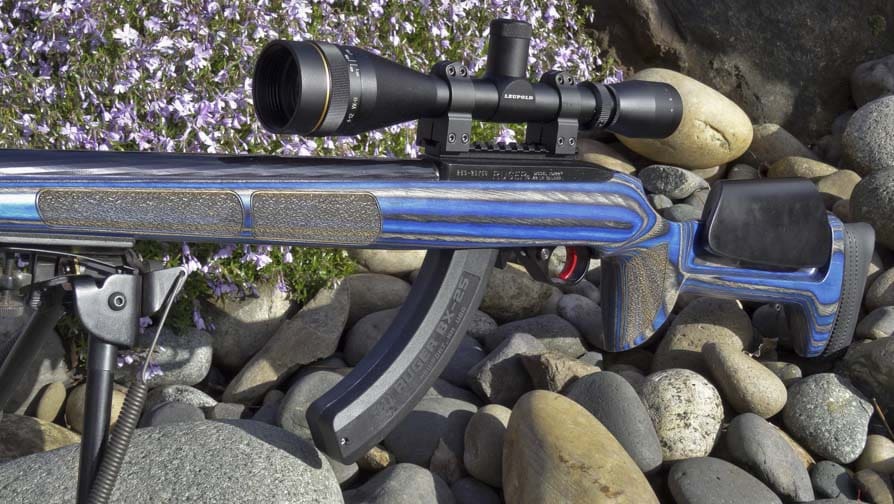
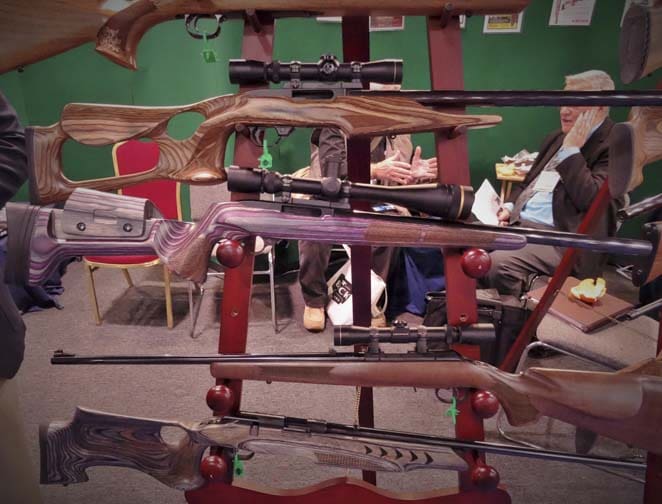


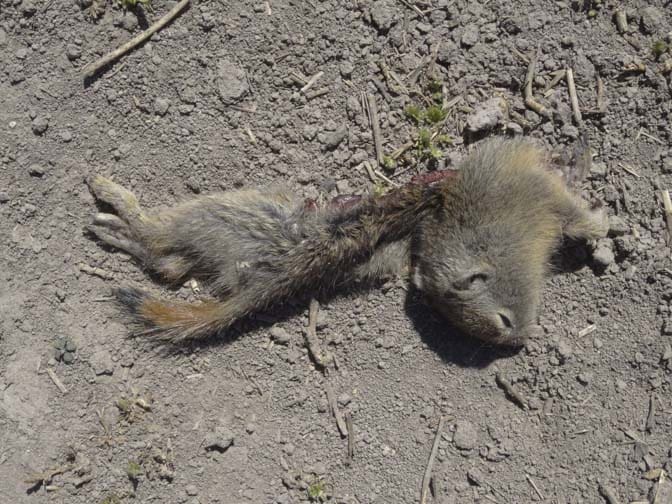
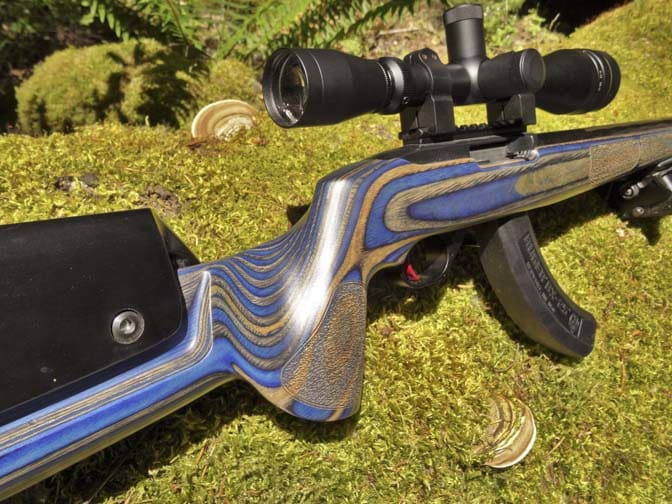
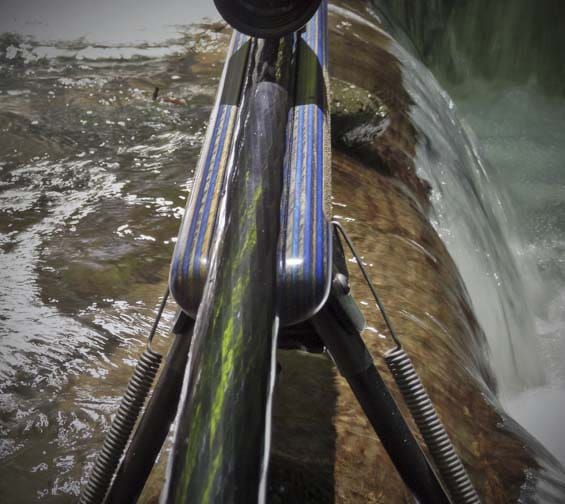
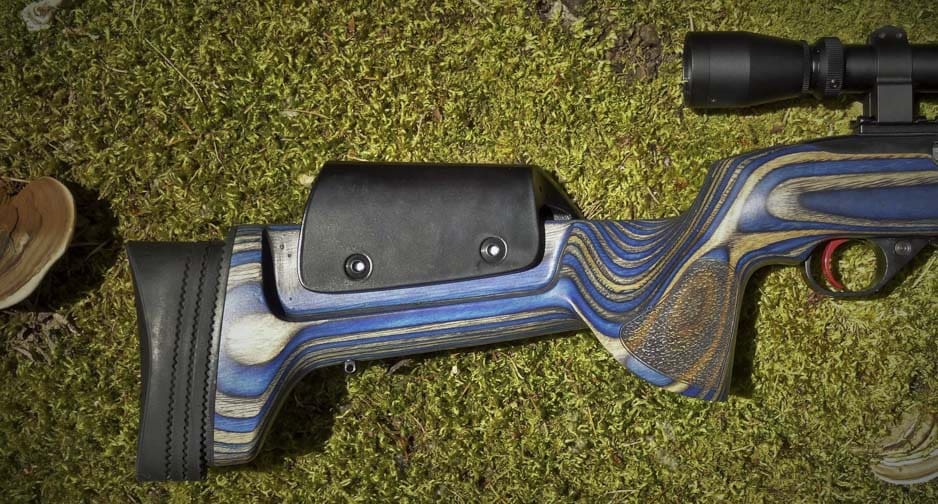
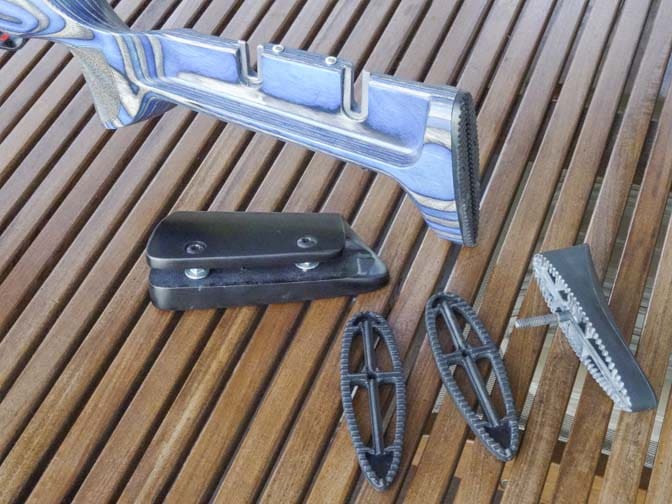
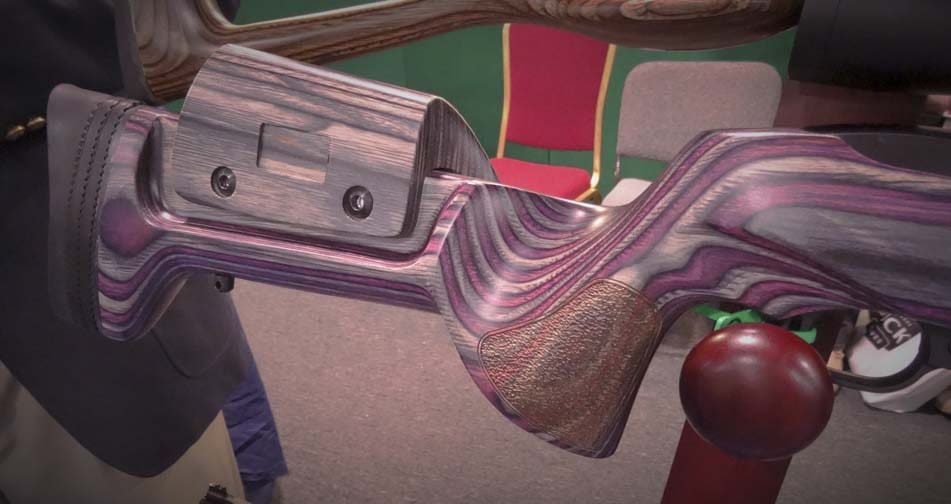
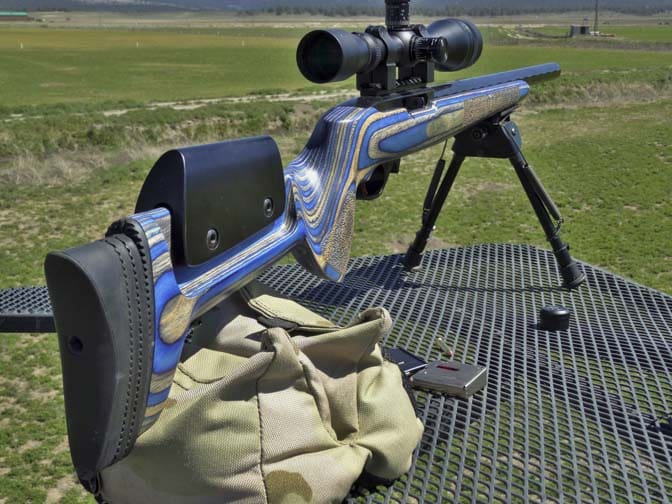



Nifty 10/22.
How does it Appleseed?
They will teach you how to use a sling as a shooting aid.
10/22 is nifty and fun but how much do you spend on plastic surgery before you just move up to a hotter gal.
Not sure how you “upgrade” from a Ruger 10/22 Target?!? This gun outshoots my Volquartsen .22LR. Are there other .22LR semi-auto’s out there that are more accurate?
That stock looks so weird.
I know I’m just a cheapskate, but I don’t get all the “fancy” 10/22 upgrades.
My Marlin 60 ($97 in 1997) with a $30 fixed 4X scope, and my Marlin 795 ($129 in 2015) work just fine for shooting sage rats.
Of course I don’t hire “outfitters” to take me sage rat hunting either. I just do it for free on friend’s farms.
I have thought about buying a .17 HMR or .22 mag. to extend my range.
Hunting ground squirrels/sage rats is a lot of fun.
Yep, me too. 225 bucks to stock a 10/22 I paid less than 160 for goes against the misers creed.
I live about 5 hours away from the nearest rat-town, so it is sooo worth it to hire an outfitter to deal with the hassle of making the arrangements with the farmers. Its the old time vs. money problem: which one do you have more of? For me, its either been one or the other, but never both at the same time! LOL! Also, Roe Outfitters brings out a two deck trailer that we shoot from, which gets the shooter about 12-15 feet off the ground. Makes a big difference, esp. late in the season when the alfalfa gets taller. We shoot rats out to 250 yards with these 10/22s, and I can guarantee you that your set up would not get you out nearly that far. Using Match ammo, I’m able to get clean head shots at 150 yards. At 250 yards, I needed to dial more than 30 MOA of elevation before I bought the 15 MOA specialized rail, and often the scope would top out before that.
I’ve got a couple of their GP100 grips. They make the old style rubber grips with the wood inserts. Good quality, low price.
“Fit: * * *
The KKC stock is a drop-in unit, and fit is decent, but not perfect. In some places, the stock’s generous cut leaves a small gap. It’s certainly on par with other stocks like by Boyd’s Blaster, and since it’s more an aesthetic issue than a functional issue, I’m not complaining.”
You may not be complaining, but 3-stars seem a bit harsh after the rest of that statement.
To me, three stars means “average.” And when I compare the fit and finish to Boyds and a few other laminate stocks I own, they seem about the same. The good news is this: its a “drop in” unit.
No double standards put DC politicians on Obamacare and SS.Thanks for your support and vote.Pass the word. mrpresident2016.com
Comments are closed.